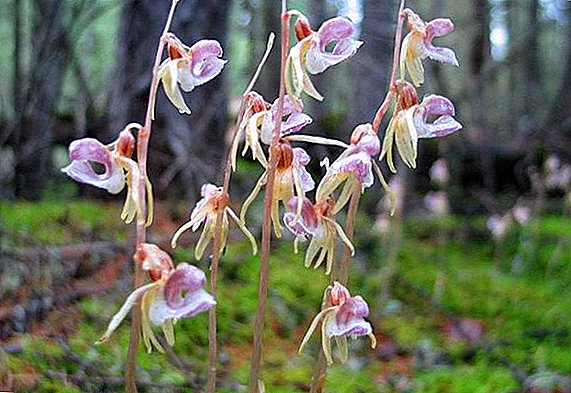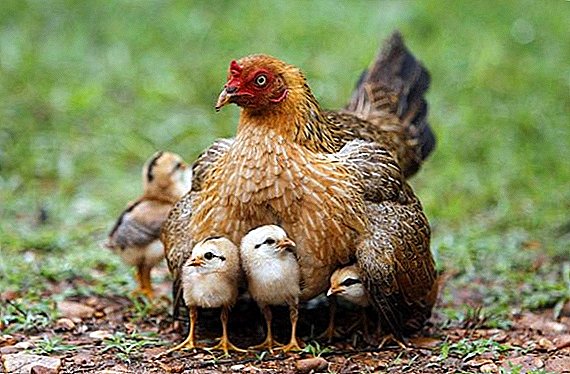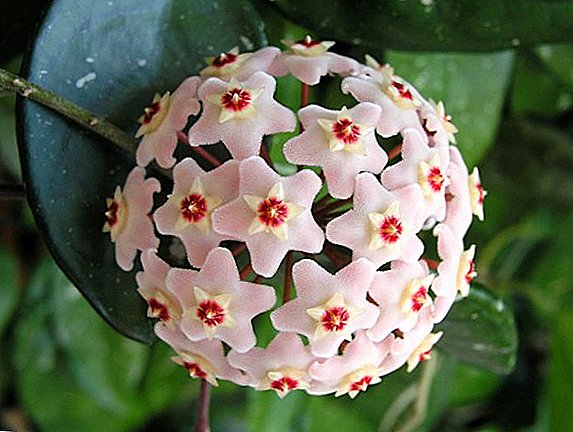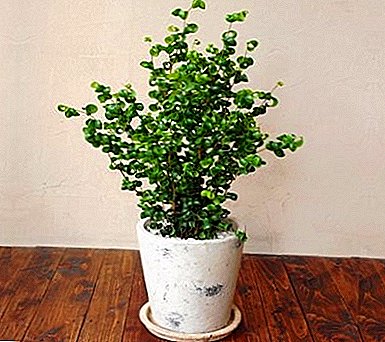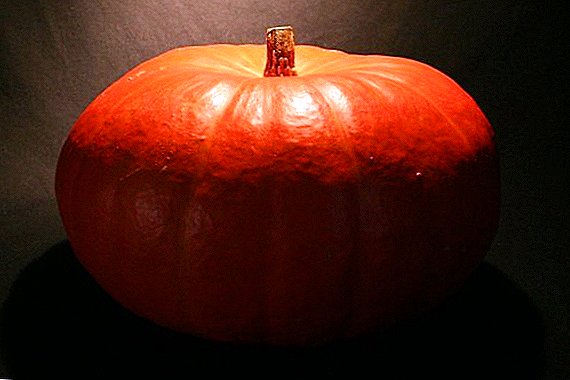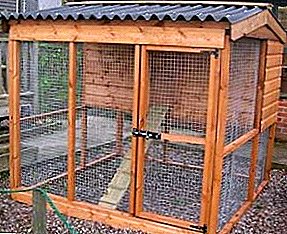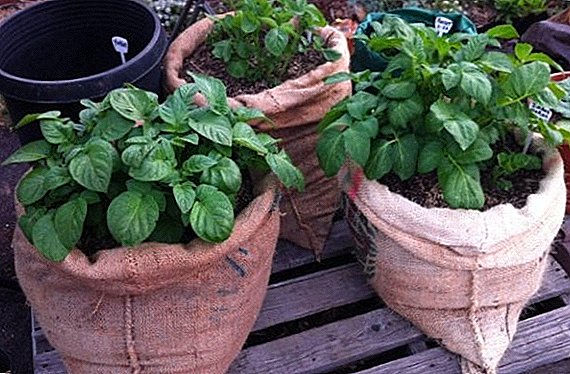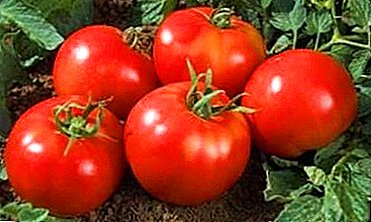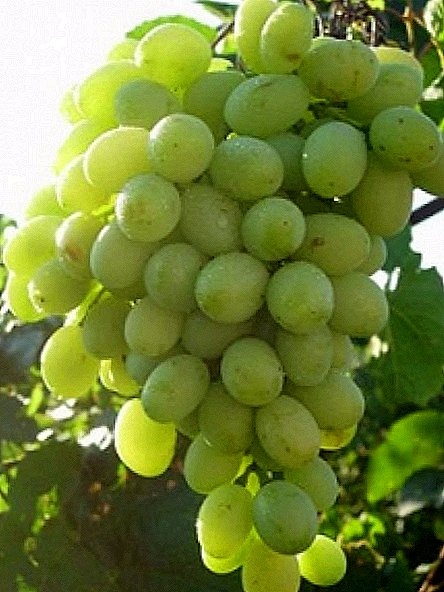
Avid gardeners and winegrowers are constantly looking for more and more new varieties of grapes for their orchards and vineyards.
Due to different climatic conditions, not all species of this plant take root, because sometimes the bushes do not withstand frost of a temperate European climate.
But such a variety as "Blagovest" is suitable for any weather and soil and will delight with its tasty fruits.
Consider this variety of grapes.
Description of the grape variety "Blagovest"

The Blagovest grape variety is the result of the work of the breeder Krainov VN, who crossed the Talisman and Kishmish Radiant varieties.
"Blagovest" is early varietybecause it ripens in 110 - 125 days around the middle of August.
Bushes grow well, many shoots bear fruit. Flowers bisexual.
The clusters are large enough, the weight can reach up to 1 kg, cylindrical or conical, the density is average.
Fruits are large, the weight of one reaches 10 g, oval in shape, light yellow in color. The flesh is juicy, has a light nutmeg aroma, is fleshy, sweet, melts right in the mouth.
"Blagovest" can withstand a temperature drop of -23 C. May be damaged by mildew and oidium, and is also subject to attack by wasps.
High yield, the weight of berries from one course can exceed 6 kg. Clusters taken off the course can be stored for a long time in a cool place, transportable.
Virtues:
- great fruit taste
- early maturation
- high yield
- high frost resistance
- long shelf life
- well maintains transportation
disadvantages:
- affected by wasps, mildew and oidium
About the features of planting varieties

Planted seedlings "Blagovest" can be both in spring and autumn, because the small fluctuations in temperature he is not afraid.
For planting lignified seedlings are used, the root system of which is well developed and matured enough.
Before landing you need a little shorten the roots (up to a length of 10 - 15 cm), as well as incise the escape, leaving two or three peepholes.
If on a sapling two or more shoots, then you need to leave the strongest. After this, the roots are dipped into a clay mash. Next, you need to dig holes for each bush. But, if you decide to plant the Blagovest saplings in the spring, it is better to dig holes in the fall and fertilize the soil in them.
A hole 80x80x80 cm is being dug under each future bush. A mixture of top soil (which was obtained by digging holes), humus, wood ash and superphosphate (approximately 300 g) is poured at the bottom of each well.
On one hole there are 2 - 3 buckets of ash and humus. The thickness of this layer should be about 40 cm.
If it was not possible to prepare the pits in advance, then this fertile layer should be compacted very well. Otherwise, the roots simply do not reach him.
Next, a seedling is placed in the pit, which is filled up first with a fertile mixture (about 5–10 cm thick), and then with ordinary soil from the bottom of the pit.
No need to fill the pit completely. It is better to leave some kind of hole around the seedlings.
The height of such a hole should be at least 10 cm, and the diameter should be about 30 cm. After the planting is completed, the seedling needs to be watered and mulched. As for the distance between future bushes, it should be at least 2 meters so that the grapes are not crowded.
Also interesting to read about the grape varieties alphabetically
Tips for caring for "Blagovest"
- Watering
Young annual bushes need regular wateringespecially in dry weather.
The first watering is done after planting, all subsequent ones should be carried out in 2 weeks.
The last time irrigation is done from 5 to 10 August.
In order for the soil to be properly soaked with moisture, you need to dig several holes 10 to 15 cm deep at a distance of 40 to 50 cm from the seedling in a circle. In these pits need to pour 4 - 5 buckets of water in a row.
Already more "adult" bushes need watering in the amount of 4 - 5 times per season.
The first spring watering should be done before the juice began to move along the shoots. If there was enough rain in the winter, you can not water the bushes. If not, then for each bush you need about 50 - 70 liters of water.
Similar watering must also be done 20 days before flowering. When the clusters have already formed, and the berries have grown to the size of peas, then the first summer watering should be done.
On one the bush must go not less than 60 l of water. The next time the bushes need to be watered 3 weeks before ripening. Before the leaves fall off, it is necessary to make water-recharge irrigation for the winter with the calculation of 60 - 70 liters per bush.
- Mulching
Mulching plays an enormous role in the development of grape bushes.
The first time a circle with a radius of about 40 cm around the seedling is covered with mulch immediately after planting.
As materials for mulching used straw, fallen leaves, plants Batva, etc.
In addition to organic materials, you can use polyethylene or special materialsFor example, mulch paper. The main function of mulch is to retain moisture in the soil.
- Shelter

Shelter grapes for the winter is a necessary procedure. After all, the roots can be damaged by frost, which ultimately will lead to the death of the entire bush.
Therefore, the protection of grapes need to think in advance.
The most favorable time for shelter comes in the middle - the end of October, when there is no frost yet, but the temperature has already decreased sufficiently.
If the foliage has already crumbled from all the bushes, then it's time to “wrap up” the vineyard.
For this you can use both natural materials and artificial. Protect the bushes can be land, burlap, plastic wrap.
For shelter bushes need to be tied up lay on the ground, fasten with metal clips, but before that lay some material on the ground (plywood, slate) so that the vines do not touch the ground. Further, metal rods in the form of arcs are installed above the bushes and one or two layers of polyethylene are pulled over them.
In addition to the film on these arches can be pulled, for example, blankets. On the side of the covering material is powdered with earth to fix.
If the temperature in winter is not very low, the bushes can be covered with earth. For this bush is "divided" in half, each half is connected and fixed on the ground.
Vines should be carefully sprinkled with earth, preferably with a slide. If snow falls, then the top snow is poured on the ground. Thus, heat and moisture will long remain in the ground. Before the shelter it is necessary to make watering irrigation.
- Pruning
The most favorable time for pruning is autumn, the beginning is mid-October.
Shortening shoots is not recommended in summer or spring, and even more so in winter. Since the shoots of grapes "Blagovest" can form many clusters, this can lead to excessive load on the bush. Therefore, an adult plant can leave an average of 25 - 30 young green shoots, that is, approximately 9 such shoots per 1 sq. M. square nutrition.
Weakened shoots must be removed so that they do not take energy from healthy branches. On vines should be 8 - 9 eyes.
If you need to prune the young seedlings, in the first year you need remove the matured vine, and after - just shorten it. When forming a bush, it is enough to leave 3 - 8 lower shoots that bear fruit, and from 2 to 5 buds.
- Fertilizer
The key to a good harvest will be regular feeding bushes. This procedure can be performed no more than 3 times during the active development of the bushes with an interval of one month.
In the first year after planting, it is not necessary to fertilize the land, as the top dressing was introduced during planting. In the second year in the spring, before they are almost completely dissolved, nitrogen fertilizers need to be applied along with organic matter.
This dressing is done with the calculation of 40 - 50 g of ammonium nitrate per 10 l of a solution of manure or compost.
In early summer, before flowering, you need to feed the earth with zinc, moles of potassium or superphosphate. After the harvest is collected, you need feed for the winter, namely to make superphosphate and potassium salts.
If a drainage system was installed during planting, then fertilizing is performed through it. If not, then you need to dig around the bush small holes 30 cm deep and fill them with fertilizer.
It is very important not to “burn” the roots with organic fertilizers. Therefore, organic matter is applied no more than once every 2–3 years with the calculation of 10–15 kg per shrub.
- Protection

Blagovest grapes bushes can be badly damaged by wasps, mildew and oidium. Protection against wasps can serve as a special mesh, which you need to wrap already formed clusters.
Mildew leaves yellow oily spots on leaves of bushes. If gray dust appears on the leaves, the bushes are infected with oidium.
The methods of struggle are the same in both cases. 3 times the grapes need to be treated with fungicides (anthracol, gates and others). First, the bushes are sprayed, when the shoots have already grown enough (up to a length of 20 cm), the second time - before the flowers bloom, and the third time - after the end of flowering.


